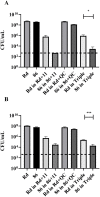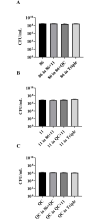The central role of arginine in Haemophilus influenzae survival in a polymicrobial environment with Streptococcus pneumoniae and Moraxella catarrhalis
- PMID: 35877653
- PMCID: PMC9312370
- DOI: 10.1371/journal.pone.0271912
The central role of arginine in Haemophilus influenzae survival in a polymicrobial environment with Streptococcus pneumoniae and Moraxella catarrhalis
Abstract
Haemophilus influenzae, Streptococcus pneumoniae and Moraxella catarrhalis are bacterial species which frequently co-colonise the nasopharynx, but can also transit to the middle ear to cause otitis media. Chronic otitis media is often associated with a polymicrobial infection by these bacteria. However, despite being present in polymicrobial infections, the molecular interactions between these bacterial species remain poorly understood. We have previously reported competitive interactions driven by pH and growth phase between H. influenzae and S. pneumoniae. In this study, we have revealed competitive interactions between the three otopathogens, which resulted in reduction of H. influenzae viability in co-culture with S. pneumoniae and in triple-species culture. Transcriptomic analysis by mRNA sequencing identified a central role of arginine in mediating these interactions. Arginine supplementation was able to increase H. influenzae survival in a dual-species environment with S. pneumoniae, and in a triple-species environment. Arginine was used by H. influenzae for ATP production, and levels of ATP generated in dual- and triple-species co-culture at early stages of growth were significantly higher than the combined ATP levels of single-species cultures. These results indicate a central role for arginine-mediated ATP production by H. influenzae in the polymicrobial community.
Conflict of interest statement
The authors have declared that no competing interests exist.
Figures






Similar articles
-
Otopathogens in the middle ear and nasopharynx of children with recurrent acute otitis media.Int J Pediatr Otorhinolaryngol. 2023 Jun;169:111552. doi: 10.1016/j.ijporl.2023.111552. Epub 2023 Apr 10. Int J Pediatr Otorhinolaryngol. 2023. PMID: 37120991
-
Otitis media pathogens - A life entrapped in biofilm communities.Crit Rev Microbiol. 2019 Sep-Nov;45(5-6):595-612. doi: 10.1080/1040841X.2019.1660616. Epub 2019 Sep 10. Crit Rev Microbiol. 2019. PMID: 31502909 Review.
-
Indirect pathogenicity of Haemophilus influenzae and Moraxella catarrhalis in polymicrobial otitis media occurs via interspecies quorum signaling.mBio. 2010 Jul 6;1(3):e00102-10. doi: 10.1128/mBio.00102-10. mBio. 2010. PMID: 20802829 Free PMC article.
-
Genetic similarity between adenoid tissue and middle ear fluid isolates of Streptococcus pneumoniae, Haemophilus influenzae and Moraxella catarrhalis from Iranian children with otitis media with effusion.Int J Pediatr Otorhinolaryngol. 2013 Nov;77(11):1841-5. doi: 10.1016/j.ijporl.2013.08.024. Epub 2013 Sep 8. Int J Pediatr Otorhinolaryngol. 2013. PMID: 24080321
-
Gene Expression Regulation in Airway Pathogens: Importance for Otitis Media.Front Cell Infect Microbiol. 2022 Feb 11;12:826018. doi: 10.3389/fcimb.2022.826018. eCollection 2022. Front Cell Infect Microbiol. 2022. PMID: 35252035 Free PMC article. Review.
Cited by
-
[Current hypotheses on the development of chronic otitis media with effusion in childhood].HNO. 2025 Apr;73(4):271-282. doi: 10.1007/s00106-025-01571-x. Epub 2025 Feb 28. HNO. 2025. PMID: 40019513 Review. German.
-
Host-pathogen interaction profiling of nontypeable Haemophilus influenzae and Moraxella catarrhalis coinfection of bronchial epithelial cells.mSphere. 2025 Jul 29;10(7):e0024225. doi: 10.1128/msphere.00242-25. Epub 2025 Jun 10. mSphere. 2025. PMID: 40492732 Free PMC article.
-
Membranome-based identification of amino acid substitution in Haemophilus influenzae multidrug efflux pump HmrM for reduced chloramphenicol susceptibility.Arch Microbiol. 2024 Jun 11;206(7):298. doi: 10.1007/s00203-024-04025-0. Arch Microbiol. 2024. PMID: 38860999
-
The Respiratory Microbiome in Paediatric Chronic Wet Cough: What Is Known and Future Directions.J Clin Med. 2023 Dec 28;13(1):171. doi: 10.3390/jcm13010171. J Clin Med. 2023. PMID: 38202177 Free PMC article. Review.
References
Publication types
MeSH terms
Substances
LinkOut - more resources
Full Text Sources
Medical

